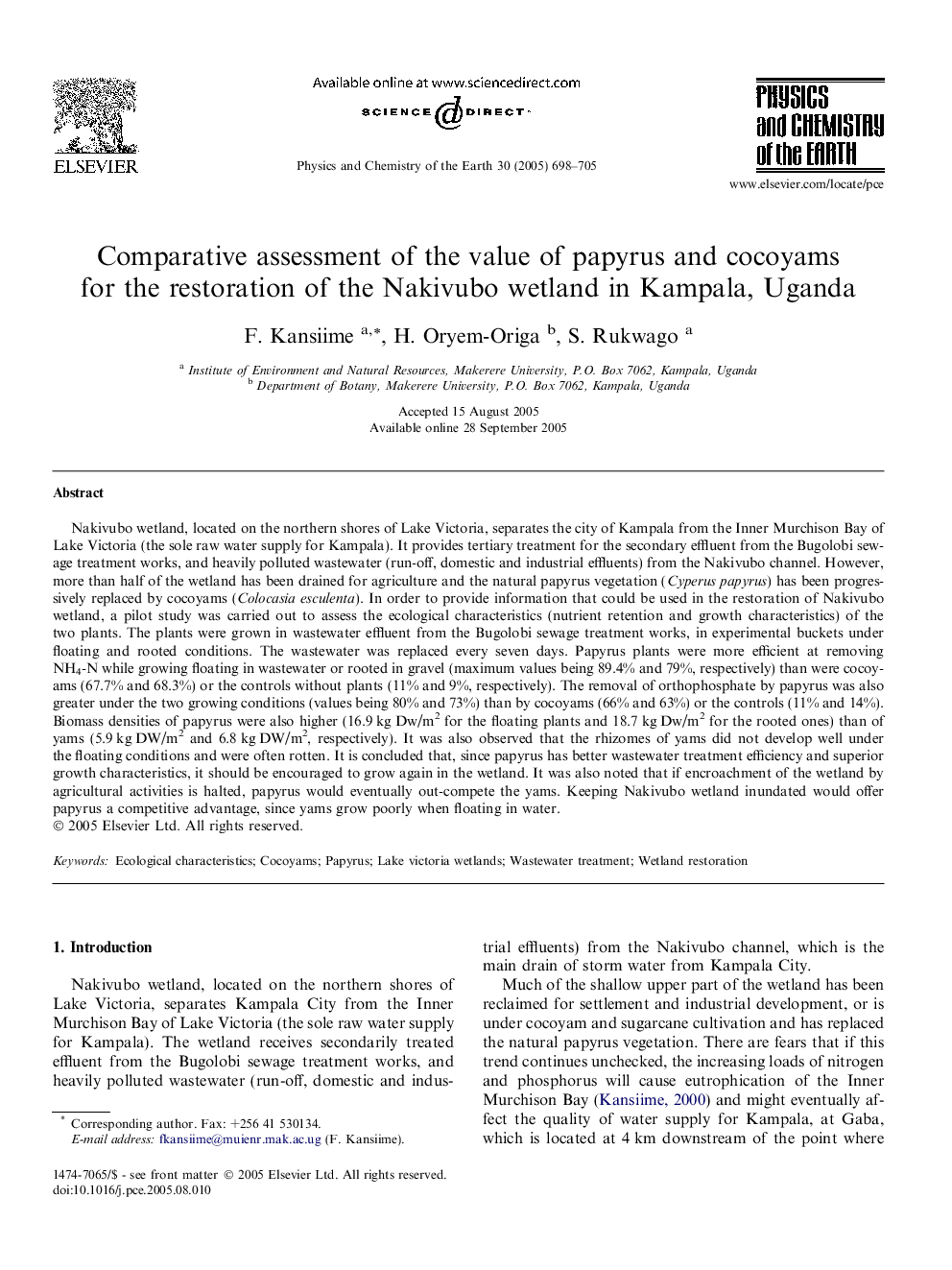| کد مقاله | کد نشریه | سال انتشار | مقاله انگلیسی | نسخه تمام متن |
|---|---|---|---|---|
| 10120016 | 1639413 | 2005 | 8 صفحه PDF | دانلود رایگان |
عنوان انگلیسی مقاله ISI
Comparative assessment of the value of papyrus and cocoyams for the restoration of the Nakivubo wetland in Kampala, Uganda
دانلود مقاله + سفارش ترجمه
دانلود مقاله ISI انگلیسی
رایگان برای ایرانیان
کلمات کلیدی
موضوعات مرتبط
مهندسی و علوم پایه
علوم زمین و سیارات
ژئوشیمی و پترولوژی
پیش نمایش صفحه اول مقاله

چکیده انگلیسی
Nakivubo wetland, located on the northern shores of Lake Victoria, separates the city of Kampala from the Inner Murchison Bay of Lake Victoria (the sole raw water supply for Kampala). It provides tertiary treatment for the secondary effluent from the Bugolobi sewage treatment works, and heavily polluted wastewater (run-off, domestic and industrial effluents) from the Nakivubo channel. However, more than half of the wetland has been drained for agriculture and the natural papyrus vegetation (Cyperus papyrus) has been progressively replaced by cocoyams (Colocasia esculenta). In order to provide information that could be used in the restoration of Nakivubo wetland, a pilot study was carried out to assess the ecological characteristics (nutrient retention and growth characteristics) of the two plants. The plants were grown in wastewater effluent from the Bugolobi sewage treatment works, in experimental buckets under floating and rooted conditions. The wastewater was replaced every seven days. Papyrus plants were more efficient at removing NH4-N while growing floating in wastewater or rooted in gravel (maximum values being 89.4% and 79%, respectively) than were cocoyams (67.7% and 68.3%) or the controls without plants (11% and 9%, respectively). The removal of orthophosphate by papyrus was also greater under the two growing conditions (values being 80% and 73%) than by cocoyams (66% and 63%) or the controls (11% and 14%). Biomass densities of papyrus were also higher (16.9 kg Dw/m2 for the floating plants and 18.7 kg Dw/m2 for the rooted ones) than of yams (5.9 kg DW/m2 and 6.8 kg DW/m2, respectively). It was also observed that the rhizomes of yams did not develop well under the floating conditions and were often rotten. It is concluded that, since papyrus has better wastewater treatment efficiency and superior growth characteristics, it should be encouraged to grow again in the wetland. It was also noted that if encroachment of the wetland by agricultural activities is halted, papyrus would eventually out-compete the yams. Keeping Nakivubo wetland inundated would offer papyrus a competitive advantage, since yams grow poorly when floating in water.
ناشر
Database: Elsevier - ScienceDirect (ساینس دایرکت)
Journal: Physics and Chemistry of the Earth, Parts A/B/C - Volume 30, Issues 11â16, 2005, Pages 698-705
Journal: Physics and Chemistry of the Earth, Parts A/B/C - Volume 30, Issues 11â16, 2005, Pages 698-705
نویسندگان
F. Kansiime, H. Oryem-Origa, S. Rukwago,